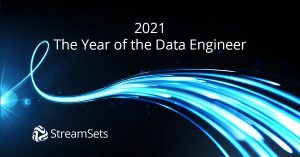Data has become one of the most powerful tools at humanity’s disposal, and it can be used for a variety of end purposes. As data experts, data engineers can take pride in their mastery of the many technical skills and practices necessary to deliver data to those who need it. Many data engineers are further inspired by the broader impact of the data they deliver – whether that is to accelerate the discovery of vaccines, thwart cyber attacks, or simply delight customers. Here’s why data engineering is critical to climate change.
In recent years, I have become passionate about both data and tackling climate change. The only way to combat climate change is to attack it from all sides: education, policy, clean technology, conservation, investment and restoration – the list goes on. There is no single silver bullet.
Why Celebrate Data Engineering on Earth Day?
 This year’s Earthday theme ‘Restore Our EarthTM’ sums up our responsibility perfectly. A web of decentralized and often interconnected decisions that produce small changes will ultimately add up to make a big difference. The common denominator across all these different potential solutions is data. Data is needed to both uncover potential solutions and to understand their impact once implemented.
This year’s Earthday theme ‘Restore Our EarthTM’ sums up our responsibility perfectly. A web of decentralized and often interconnected decisions that produce small changes will ultimately add up to make a big difference. The common denominator across all these different potential solutions is data. Data is needed to both uncover potential solutions and to understand their impact once implemented.
In other words, data is critical to tackling climate change, and data engineers have a critical role to play. Here are 4 ways data engineers are helping tackle climate change today.
4 Ways Data Combats Climate Change
1. Changing Consumer Behavior
Using data to change customer behavior is a very long and complex data value chain, but one worth tackling when you are a global energy giant like Royal Dutch Shell. The company has set a climate target to become a net-zero emissions energy business by 2050. Their Renewables and Energy Solutions business unit attacks this goal on many fronts, investing in and deploying electricity, wind, solar, EV charging, biofuels, and more.
But a big part of meeting Shell’s targets will come in how their customers use energy. The Shell.ai network turns massive amounts of data into insight by providing self-service analytics to business teams across the company. One of the areas they are tackling? How to notify drivers of the optimal time to recharge their cars, not just because their battery is low, but when it will have the least effect on the power grid.
2. Investing in Climate-friendly Infrastructure
Data engineers at Generate Capital deliver the data used to track the performance of sustainable infrastructure and allocate capital more effectively. Because getting to big climate change requires more than behavior change, we have to put our money where our mouth is (as a society).
Generate Capital delivers resource solutions to companies, communities, and cities through a sustainable infrastructure platform. Generate builds, owns, operates, and finances sustainable resource infrastructure like solar farms, efficient water pumps, and wind farms. They track the performance of the infrastructure that Generate backs — how much energy is generated or stored, for example — and report back to the people who invest in it. Financial transparency and efficient operations both require timely, clean data.
3. Optimizing Distributed Energy Resources and Smart Grids
When you install solar panels, a battery, even a smart thermostat or smart lightbulbs in your home, all those devices have to inter-operate with your utility’s electrical grid. Data is critical to ensuring that interoperation of these types of distributed energy resources goes smoothly and that utilities can run the grid safely, even when millions of devices in homes and commercial buildings are out of the utility’s control.
Power companies used to have a fixed set of energy generation assets (coal plants, nuclear plants) they controlled completely. Now they have to factor in electric vehicle charging stations in parking lots, solar panels on individual homes, wind farms, etc. Utility companies use data streaming from all of these things in real-time to know what’s going on and to manage the grid. For example, they might prompt a corporate campus to use air conditioning to cool offices at 1pm instead of 4pm to increase efficiency and better balance power demands.
4. Crowdsourcing Data for Environmental Justice
PurpleAir maps air quality using sensors in backyards. Here in the SF Bay Area, we all got to know it intimately last summer during the wildfires. PurpleAir became so popular because of the granularity of their air-quality data. Where the EPA may have 1-2 sensors per city, Purple Air has dozens or hundreds reporting in 10-minute increments. This is excellent for wildfire season when you get to open your windows for a precious few minutes a day. Nonprofits also use it, like the Coalition for Clean Air in Los Angeles, which gives PurpleAir monitors away for community members to track air quality in low-income neighborhoods.
Data engineers can tap into crowd-sourced data, whether that be from air quality sensors, GPS units on trucks, or people’s smartphones, to both, inform communities about issues and to gather the fact base to drive changes in policy and spur investment.
How to ‘Help Restore Our World’ Today
Watch the news on any given day and you’ll see plenty of ways we need to restore our world. The climate change situation is beyond critical, and data engineers have a role to play in the solution. Data will help people change behavior, redirect capital investment, optimize the power grid, and ensure more equitable use of resources. That’s one of the many reasons, we’re calling 2021 the Year of the Data Engineer.
This Earth Day, we celebrate data engineering for a purpose and the data engineers in our community who are doing this work. Inspired? Think about becoming a data engineer. There’s one thing that’s certain – the world needs all of us!

